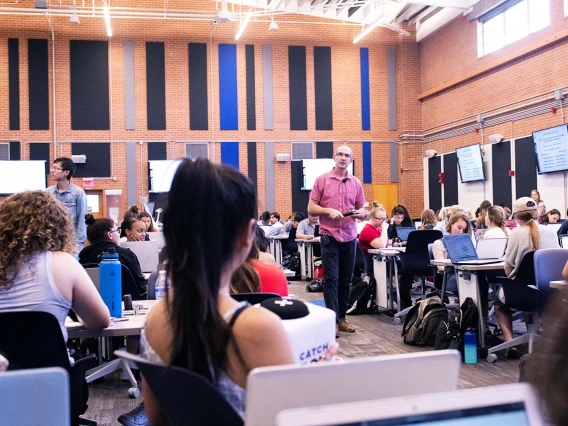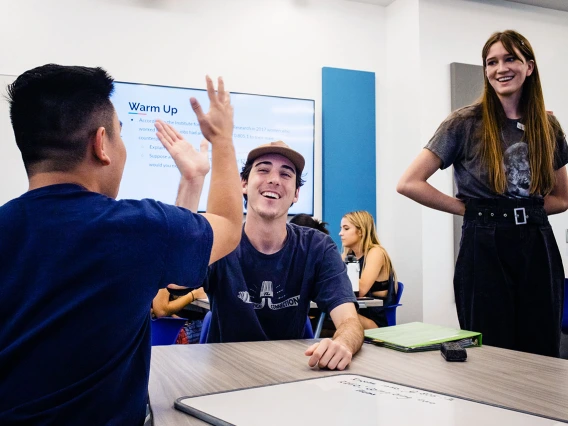Explore the story of U of A's commitment to innovative learning environments.
The Collaborative Classrooms Initiative represents a campus-wide, coordinated effort to transform learning environments and support evidence-based teaching practices that help students learn and achieve more.
From Pilot to Campus-Wide Transformation
The Beginning: Science-Engineering Library Pilot
The first initiative was a fast-paced pilot project that transformed the Science-Engineering Library's Journal Room (Room 200S) into a large, 260-seat collaborative classroom. During the month-long pilot, eight University of Arizona classes explored this active-learning space to better understand the technology, physical space requirements, and pedagogical needs for building effective collaborative learning environments.
Based on the encouraging results, the university made a decision to convert the Science-Engineering Library space into a permanent collaborative classroom and actively pursue opportunities to transform existing classrooms across campus.
Read the Classroom Redesign for Active Learning Pedagogies Report (2015)
Collaborative Learning Spaces Project Video (2015)
Continued Growth: Building Our Portfolio
Beginning in Spring 2019, the University launched its strategic plan to transform fifty percent of centrally-scheduled classrooms into collaborative learning environments.
Milestones
- Fall 2019: Thirty-two innovative learning spaces completed, with occupancy ranging from 24 to 264 students
- Included: Five specialized Flexible Learning Spaces with mobile furniture
- Goal: Transform 50% of centrally-scheduled classrooms
2018-2019 Collaborative Classroom Campus Map
Featured Spaces
From small experimental classrooms to large auditoriums with breakout spaces, our diverse learning environments adapt to every teaching style and class size, creating the perfect setting for student engagement and academic growth.

Gittings Room 129B
- Capacity: 264 students
- Special Feature: Adjacent huddle-in and huddle-out spaces for smaller group discussions before and after class
- Innovation: Seamless transition between large-group instruction and small-group huddles

Albert B. Weaver Science-Engineering Library Room 200S
- Capacity: 260 students
- Significance: Our founding collaborative classroom that proved the concept
- Legacy: Permanent installation that launched campus-wide transformation

Flexible Learning Spaces (5 locations)
- Capacity: 24-80 students
- Special Feature: Swivel chairs with wheels and personal work surfaces
- Opportunity: Perfect for instructors exploring collaborative activities
Collaborative Classroom Design Blueprint
Essential Collaborative Classroom Characteristics
Every collaborative classroom includes:
- Flexible Seating: Round or rectangular tables for 4-6 students that instructors and learning assistants can easily access
- Mobility: Adjustable-height swivel chairs for comfort and flexibility
- Visual Access: Projectors/screens and monitors throughout the room, ensuring all students have a good view of materials
- Technology Ready: Enhanced networks to accommodate courses with heavy technology use
- Power Access: Ample power outlets at tables or around the room perimeter
- Acoustic Design: Sound-absorbing carpet for better acoustics
- Welcoming Environment: Splash of color on accent walls to create an inviting learning atmosphere
- Collaboration Tools: Tabletop whiteboards for each table
Beyond Traditional Collaborative Classrooms
Active-Learning Halls
Many instructors find creative ways to engage students in large lecture halls using tools like pair & share activities, polling apps, and laptop whiteboards.

Huddle Spaces
Adjacent spaces for smaller group discussions that complement some large collaborative environments.

Get Support
For questions about course suitability, classroom features, or teaching strategies contact Tina Deemer.

